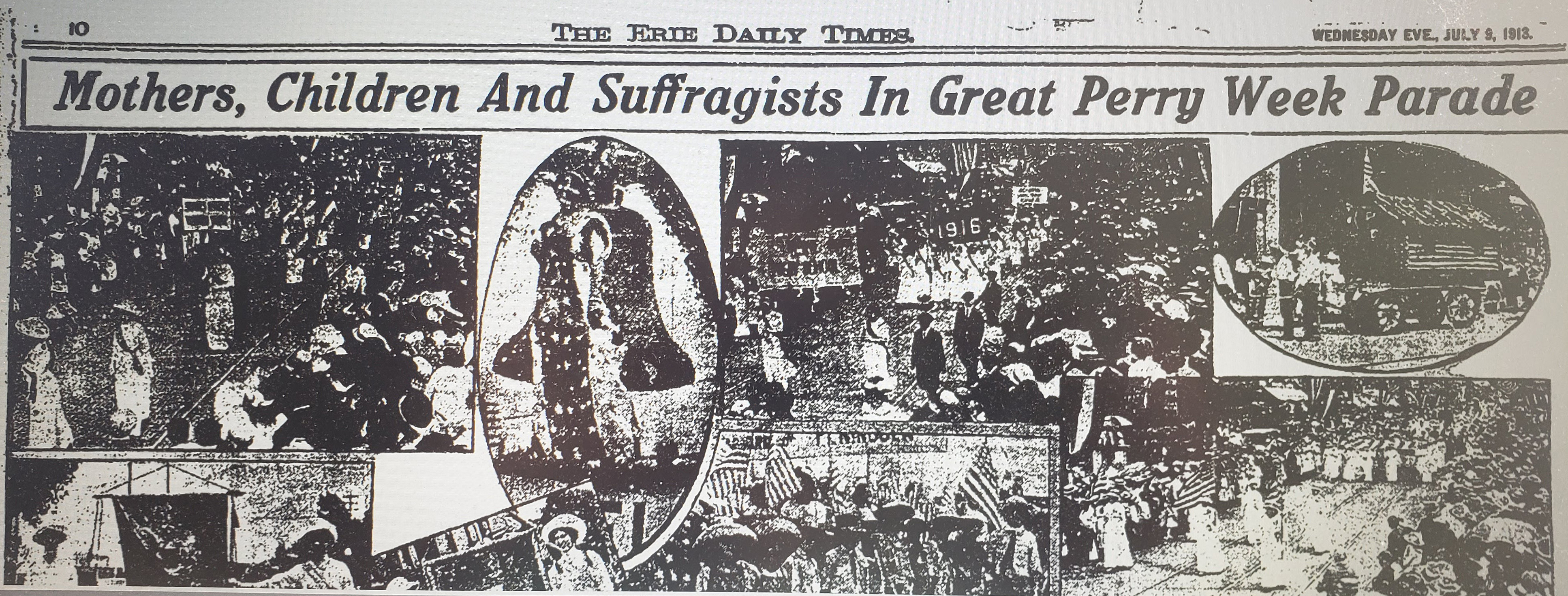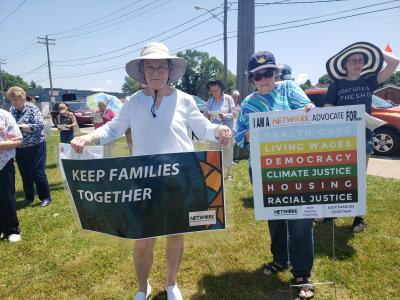Marching Orders, Then and Now
Erie stands up for democracy
"Gain a victory over fear and walk firm and erect. … Remember that you are only one in a great army – that you are marching for a principle and that principle (is) 'Government of the People for the People and by the Whole People.'"
Today, such advice might have appeared on social media posts, in Substack essays, or on podcasts, drumming up support for Erie's two No Kings protests on June 14, for a pop-up rally, "Keep Families Together," at West 12th and Peninsula on June 19 by the local chapter of Network Lobby, or for the "Sisters Speak Out; Prayer and Public Witness for Immigrants and a Just Economy" vigil on June 24, across from the Erie County Prison at West 18th and Ash streets.
But those words advocating for government "by the Whole People" date to July 5, 1913, when Augusta Fleming wrote a letter to the editor of the Erie Dispatch. Her mission: persuade Erie women to join her, other local suffragettes, and supporters from Cleveland, Pittsburgh, and Buffalo in the Perry Centennial Parade, set for Tuesday afternoon, three days after the letter ran.
Fleming spoke with authority and conviction. "All women should feel the duty to pass on to their daughters the rich heritage of political freedom," she stated in her letter, adding that there would be the sound of "feet, a thousand times ten thousand and thousands and thousands" standing up for women's right to vote.
In 1913, she served as president of the Erie Equal Franchise Association and by 1920, she had become chair of what was described as a "temporary" organization, the League of Women Voters. The league worked to assure that Erie women followed the proper procedures to be eligible to vote for the first time in the November election, following the certification of the 19th Amendment on Aug. 26 that year.
To explain those procedures, a "mass meeting" was held at the Erie County Courthouse with 18 organizations represented, including the Woman's Club, the YWCA, Zonta, the Erie Infants Home, the Housewives League, the Public Library, and the PTA, according to newspaper accounts.
I can't definitively assert that Fleming and other suffragists from Erie would have joined the No Kings protests or advocated to protect the rights of immigrants, as many are doing in Erie these days. But anecdotally, I see evidence that these women would have felt right at home making banners and carrying signs to stand up for democracy and to speak out for the marginalized.
Today, one energizing part of attending a rally or protest is spotting all the clever signs. At the
Perry Centennial Parade, the suffragists also knew how to make a visual splash, wearing costumes and sashes and pulling a plaster replica of the Liberty Bell on a float, which the Erie Daily Times described as a "prominent feature" that day.
The parade's date was also significant; July 8 was the 137th anniversary of the day the Liberty Bell rang out in Philadelphia for the first public reading of the Declaration of Independence. In 1920, another bell, known as the Justice Bell, would travel to every corner of Pennsylvania, including Erie, with a pledge that the bell would remain silent until the 19th Amendment was ratified.
In 2020, a 200-pound resin replica of the Justice Bell was displayed at the Hagen History Center to commemorate the 100th anniversary of women's suffrage. More information about the original Justice Bell and how it was salvaged can be found at justicebell.org.
In her letter to the editor, Fleming referred to the "unselfish motive" behind those supporting women's right to vote. "You are trying to gain citizenship that you may do your part to bring about better legislation for the protection of the home, children, and the weak," she wrote. The reference to women needing to "gain citizenship" strikes a nerve. Without the right to vote, women did not enjoy the full benefits of citizenship.

In 1913, this headline appeared in the evening edition of the Erie Daily Times reporting on a protest led by suffragette Augusta Fleming who, while rallying attendees for the march, said that there would be the sound of "feet, a thousand times ten thousand and thousands and thousands" standing up for women's right to vote. (ETN)
Now I watch in disgust as the Trump administration rounds up people with the legal right to be here, even if they aren't yet citizens.
At the prayer vigil across from the Erie County Prison, organized by the Sisters of St. Joseph, the Sisters of Mercy, and Benedictines for Peace, participants learned about a Haitian woman in Erie who is being deported even though she had received legal asylum. "She has a job," said Sister Jacqueline Sanchez-Small, OSB. In Haiti, she can only be returned to the household where she worked for 19 years as an unpaid servant, Sanchez-Small said.
Sister Natalie Rossi, RSM, talked about a friend named Tom, originally from India, who earned his MBA from Gannon University and become close friends with the Sisters of Mercy in Erie, attending Catholic Mass with them and joining them for Sunday brunch.
After getting married in India, and with a good job awaiting him in Erie, he returned with his new wife and "then began the nightmare," Rossi said. The newlyweds received emails telling them they had three days to self-deport or face a daily fine of $900 – each. They left Erie but were able to settle in Dubai and work remotely for the Erie company that had hired him.
"If you see something that is not right, we can't afford to be quiet," Rossi said, quoting civil rights icon and late Congressman John Lewis. "Let's get into some good trouble."
Deb Seng, social justice coordinator for the Sisters of St. Joseph, said the prayer vigil in Erie was one of many "echo rallies" held across the country in conjunction with a Sisters Speak Out vigil on the grounds of the U.S. Capitol at the same time.
Planning began in March at a meeting of the Leadership Conference of Women Religious. "A sister stood up and said, 'We cannot be silent anymore. We have the moral authority to speak truth and right and we have to have our voices heard."'
Erin Falk, 23, of Buffalo, was among 50 people who attended the vigil. She is one of three young women known as Benedictine Peacemakers, who are spending a year in Erie learning about monastic life. Seeing elderly people, many of them religious sisters, at the prayer service inspired her, she said. On a 90-degree afternoon, they "came out to protest. They're still willing to fight," she said.
No matter their age or the organizations they represent, Erie people have proven their willingness to fight for what is right for more than a century.
When she died in 1949, Augusta Fleming's age was estimated to be 72, but her birth date "was not ascertainable," according to her death certificate. She would likely be appalled at Republican-backed legislation demanding that people produce their birth certificates to be able to register to vote.
But doing the math, I do know this: In 1913, Fleming would have been around age 36 when she led the Erie suffragists in demanding voting rights for women. If there had been a 40 Under 40 list compiled then, she surely would have been one of those honored.
Liz Allen attended her first protest rally, against the draft, with her brother in 1968. She can be reached at lizerie@aol.com




